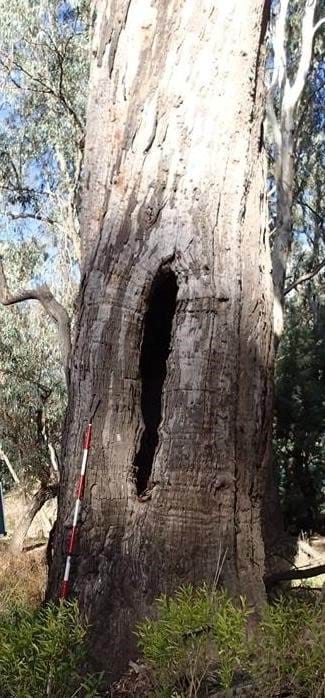Characteristics
- scar more-or-less regular in shape, often with parallel sides and slightly pointed or rounded ends
- scar usually stops above ground level
- exposed sapwood free of tree knots or branches or evidence of a branch having been at the top of the scar
- exposed sapwood at the base and (more rarely) at the top of the scar may show stone or steel axe cuts
- tree is an Australian native species which occurs naturally in the district
- tree is usually over 200 years old

What are scarred trees?
Aboriginal people caused scars on trees by removing bark for various purposes. The scars, which vary in size, expose the sapwood on the trunk or branch of a tree.
Where are scarred trees found?
Scarred trees are found all over Victoria, wherever there are mature native trees, especially box and red gum. They often occur along major rivers, around lakes and on flood plains.
Why did Aboriginal people remove bark?
Aboriginal people removed bark from trees to make canoes, containers and shields and to build temporary shelters.
They also cut toe holds in trees to make them easier to climb. This allowed them to use trees as lookouts, hunt for possums or bee hives, and cut bark higher up in the tree. Sometimes trees were carved or decorated, but examples are rare in Victoria.
To remove bark, Aboriginal people cut an outline of the shape they wanted using stone axes or, once Europeans had arrived, steel axes. The bark was then levered off. Sometimes the axe marks made by Aboriginal people are still visible on the sapwood of the tree, but usually the marks will be hidden because the bark has grown back. The amount of bark regrowth may help you tell the age of the scar. Sometimes, if the scar is very old, it will be completely covered by regrowth.
What other human activities can cause scars?
European settlers also removed bark from trees to build huts. Generally, these scars will be more square or rectangular in shape than those created by Aboriginal people.
Boundary or survey markers made by European settlers and farmers also caused scars. Survey markers are usually triangular and may have a number or date carved or written on the sapwood.
Trees close to roads may be damaged by passing vehicles. Scars caused in this way will usually only occur below a height of about two metres.
What natural processes can cause scars?
Fire, lightning, storms and floods can also cause scars on trees.
Fire damage is distinctive: the scar is usually triangular, wide at the base and tapering up from the ground, and the wood is charred. A scar caused by a falling branch often looks like a ‘keyhole’, with the stub of the branch at the top and a tail of torn sapwood beneath.
Scars caused by falling trees can sometimes be identified by examining nearby tree stumps.
These will usually give some idea of the direction in which the tree fell. If that direction matches the position of the scar, the scar may be natural.
Why are scarred trees important?
Scarred trees provide valuable clues about the use of perishable materials by Aboriginal people. Because wood often rots away, Victorian museums have only a small number of Aboriginal wooden artefacts. Most of our information on Aboriginal use of wood comes from the writings of early settlers and explorers.
Scarred trees are easier to find than many other archaeological sites.
They tell us where Aboriginal people used to live, and help us find other types of archaeological sites, such as scatters of stone tools. Scarred trees also provide Aboriginal people today with an important link to their culture and their past.
Threats to scarred trees
Scarred trees are disappearing because of natural ageing and decay, timber cutting, environmental problems such as salinity and fire. First Peoples - State Relations records scarred trees so that we will have a permanent photographic and written record of this important part of the heritage of all Australians. Some scarred trees require attention, so they will be preserved for future generations.
Are scarred trees protected?
All Aboriginal cultural places in Victoria are protected by law. Aboriginal artefacts are also protected.
It is against the law to disturb or destroy an Aboriginal place. Artefacts should not be removed from sites.
What to do if you find a scarred tree
- check the scar for key characteristics
- record the tree’s location and its condition
- note whether it is under threat of disturbance
Please help to preserve Aboriginal cultural places by reporting their presence to First Peoples - State Relations.
Updated

